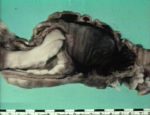Difference between revisions of "Category:Intestine - Physical Disturbances"
Jump to navigation
Jump to search
| Line 20: | Line 20: | ||
==Positional Changes/ Displacements== | ==Positional Changes/ Displacements== | ||
| − | ===Hernia=== | + | ===[[Hernia]]=== |
| − | |||
| − | |||
| − | |||
| − | |||
| − | |||
| − | |||
| − | |||
| − | |||
| − | |||
| − | |||
| − | |||
| − | |||
| − | |||
| − | |||
| − | |||
| − | |||
| − | |||
| − | |||
| − | |||
| − | |||
| − | |||
| − | |||
| − | |||
| − | |||
| − | |||
| − | |||
| − | |||
| − | |||
| − | |||
| − | |||
| − | |||
| − | |||
| − | |||
| − | |||
| − | |||
| − | |||
| − | |||
| − | |||
| − | |||
| − | |||
| − | |||
| − | |||
| − | |||
| − | |||
| − | |||
| − | |||
| − | |||
| − | |||
| − | |||
| − | |||
| − | |||
| − | |||
===Volvulus=== | ===Volvulus=== | ||
Revision as of 12:42, 1 June 2010
Intestine - Physical Disturbances
Category:Obstruction, Intestinal
Positional Changes/ Displacements
Hernia
Volvulus
- A twist about the long axis of the gut.
- Generally in the small intestine.
- Intense congestion
- Often almost black.
- Mostly in young animals
- Especially calves and piglets
- Occasionally sheep and dogs.
- Occasionally in greater mesentery of horse.
Pathogenesis
- Loop of bowel twists through 180 degrees around mesentery to produce obstruction of lumen.
- Proximal the the obstruction, the bowel becomes rapidly distended.
- Venous return is first shut off, but the arterial supply remains.
- Bowel becomes engorged with blood.
- Produces rapid death.
- Venous return is first shut off, but the arterial supply remains.
- Bowel becomes hypoxic.
- Toxic material and bacteria pass through the anoxic wall of bowel.
- In piglets may see whole of small intestine twisted around root of mesentery.
- Very little can be done to resolve this** Produces rapid death
Torsion
- A twist across the long axis of gut.
- Most common in the colon of the pig and the horse
Intussusception
- Telescoping of one segment of the bowel into another.
- Occurs in all species.
- Particularly in young dogs.
- Can occur in the small intestine, caecum or colon.
Clinical
- Intussusception is a less acute type of obstruction.
- Produces intermittent diarrhoea.
- Animals go downhill in a few days.
- Palpation of abdomen may allow a "Cumberland sausage" effect to be felt.
- NB abdominal palpation in small animal, rectal palpation in large animal.
Pathogenesis
- Proximal intestine invaginates into lower part of intestine.
- Takes mesenteric attachment with it.
- Compression of the mesenteric vessels obstructs venous drainage of the gut, resulting in venous congestion.
- Swelling (oedema/congestion) arises.
- Inflammatory exudate from serous surface.
- Fibrinous adhesions form between surfaces making structure irreducible.
- Inflammatory exudate from serous surface.
- Swelling (oedema/congestion) arises.
- May progress to necrosis and gangrene of the tissue.
- There is often functional obstruction to bowel.
- May rupture, leading to peritonitis and death.
- Associated with anything that raises peristalsis e.g. change in diet, bacterial infection.
- Foreign body
- Intramural abscess/tumour
- Heavy parasitism
- Previous intestinal surgery
- Enteritis
- Other motility disorders.
- Change in diet
- Bacterial infection
Pathology
- When operate or at post mortem see large sausage shaped distension of length of intestine.
- Intussusception may occur post mortem
- There are no associated changes
- The condition is easilt reducible.
Rectal prolapse
- Pig, sheep, cattle
- Related to prolonged tenesmus, e.g.
- Colitis
- Urinary infection
- Obstruction
- Hepatic failure.
References
Brown CC, Baker DC, Barker IK: Alimentary System. In: Jubb, Kennedy and Palmer's Pathology of Domestic Animals, ed. Maxie MG, 5th ed., pp. 1-296. Elsevier, Philadelphia, PA, 2007.
McGavin DM & Zachary, JF: Pathologic Basis of Veterinary Disease, 4th ed, pp. 301-393.Elsevier, St. Louis, Missouri, 2007.
Pages in category "Intestine - Physical Disturbances"
The following 5 pages are in this category, out of 5 total.


